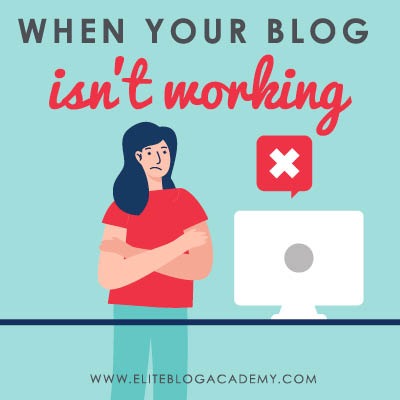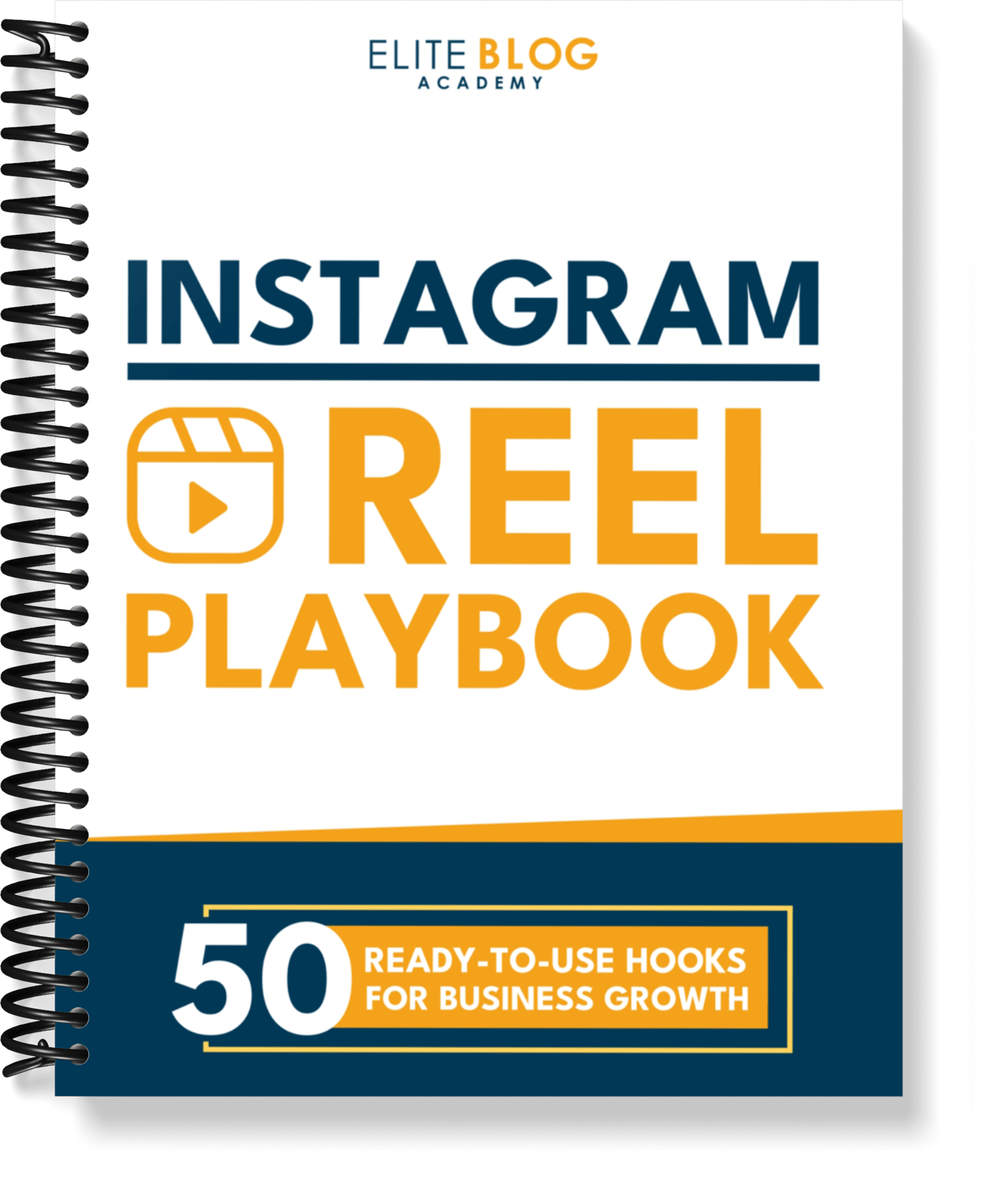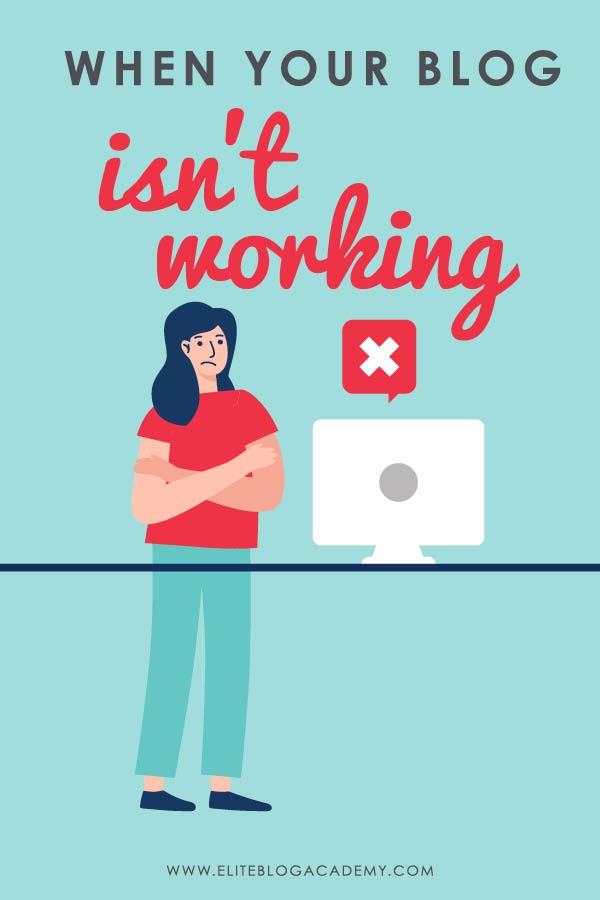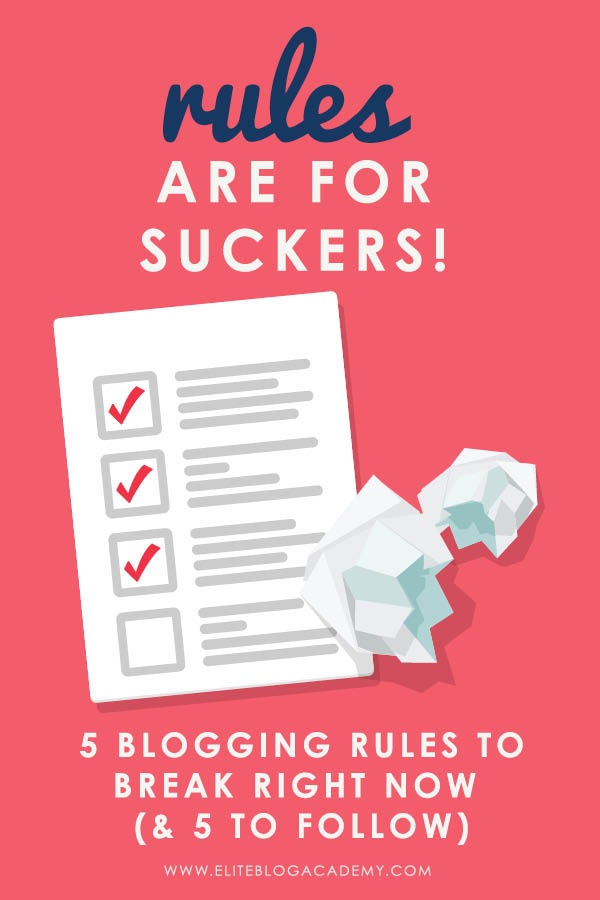When Your Blog Isn’t Working

Frustrated by a lack of results on your blog? When nothing seems to work, it may be tempting to start over or throw in the towel altogether. Before you make a drastic change, check out these reasons your blog may not be working (and the next steps to get your blog back on track)!
Here’s a scenario I see happening a lot in the blogging world:

Struggling to create Reels that grab your dream customer?
Our Instagram Reel Playbook will not only give you 50 ready-to-use hooks, proven to grab your audience’s attention from the start, but we’ll show you our proven strategy for reels that convert.
Karen started her blog about 10 months ago. She has a TON of content… but unfortunately, that’s about all she can say. She’s not seeing any results — not a lot of traffic, not a lot of income. She can’t quite figure it out and all she knows is that it’s not working. She’s so frustrated!
She’s been writing and writing and writing — and it feels like nothing ever comes from it. Every day she wonders, “should I keep going… or should I throw in the towel?” On the one hand, Karen doesn’t want to give up on a blog she feels passionate about. But on the other hand, she doesn’t want to waste any more time working on a blog that’s never going to take off.
So what is Karen supposed to do? Does she pivot and take her blog in a whole new direction? Or does she persist and try to power through with what she has already created?
Raise your hand if you can relate to Karen’s struggle.
I would dare to guess that there are a lot of hands raised behind that screen right now and believe me, I’ve been there too. Every blogger experiences plateaus and roadblocks, or periods where it feels like whatever we are doing just isn’t getting the results we were hoping for.
But when we struggle and feel like something in our blog just isn’t working, the first thing we should probably do is ask the toughest question of all: WHY?
WHY aren’t our efforts paying off? Do we really feel a real connection to our audience? Do we know who they are and what they struggle with? Why are we writing to them? Is our writing impacting them in a real way? Are we still even passionate about the topics we cover? Have we chosen a niche that people actually care about?
There are so many possible reasons why we don’t get results we want, but before we make the decision to pivot or persist, we need to dig deep and figure out what’s really going on.
Here are some possible reasons your blog may be struggling and some action steps to overcome them.
When Your Blog Isn’t Working
The Blog Topic Is Too Narrow
When choosing a blog topic, we want to niche down and write about something people will connect with on a personal level. But if we go TOO narrow with our topic and write about something super obscure, we run the risk of not having enough people interested in what we’re talking about.
While having a super targeted blog is a benefit and not a pitfall, we need to make sure there’s an audience that wants it.
One of our EBA students has a blog that’s all about hair loss. Now, a blog about hair loss will not appeal to people who aren’t losing their hair. But to people who struggle with hair loss, this blog is everything they’re looking for! They’re looking for solutions, a community, and other people who understand what they’re going through.
Even though there’s a limited number of people interested in the topic, the people who ARE interested are super passionate and engaged so it totally works.
Take Action
If you think your topic might be too narrow, validate the hunch.
First, go inward. Ask yourself: is this a topic I could write about for years without getting bored? Can I consistently come up with new ideas around this topic, or will I be rehashing the same things over and over?
If you can’t sustain interest in your topic for an extended period of time, you can’t expect your readers to either.
If you decide your topic is something you can write about in new and interesting ways for years to come, then that’s great! But you still need to make sure other people will want to READ about it for years to come.
Here’s a basic rule: no audience, no blog.
Send out a reader survey to gauge your audience’s interest in your topic. Ask them what they’d really like to read about. If your audience is losing interest in your topic, it’s probably time to go back to the drawing board and figure out a way to broaden your topic to appeal to a wider demographic.
Having a narrow focus for your blog is a great thing — just don’t go too narrow that you alienate your audience.
The Blog Topic Is Too Broad
We don’t want our topic to be too narrow, but it shouldn’t be too broad either.
When we write too generally, we can miss out on forging a real connection with our audience. Readers need to feel like we understand them and what they’re going through. If our topic is too broad, we miss the opportunity to connect on a one-to-one level.
Now don’t get me wrong–sometimes broad can really work. My main blog, Living Well, Spending Less, covers just about everything there is when it comes to offering practical solutions for women who want to make their lives easier.
But, there’s a subtle nuance: even though LWSL covers a lot of ground, it’s all built around a common theme: practical solutions. The women who read our blog aren’t necessarily passionate about recipes or organizational tips or financial strategies specifically. They’re interested in finding practical solutions to their problems. As long as the content ties back to that central theme, it works.
When a blog is sporadic and covers all sorts of topics without a central thread, it can be too broad for people to get excited about.
Take Action
If you think your blog might be too broad, you might want to take a close look at your content.
What’s your theme? Is there a common thread that runs through all of your content?
If you think your blog might be too broad, you might want to take a close look at your content.
If there is no common thread and your approach to content is, “Hmm… well, this is what I feel like writing about today so I’m going to write about it!,” you might have trouble finding and connecting with an audience. It’s tough to connect with a blog about shoes, yoga retreats, and politics unless there’s a common thread holding it all together.
Try revisiting your strategy and editorial calendar. Hone in on what your blog is about and how each piece of content fits into your overall theme. If a topic doesn’t fit into your theme (and doesn’t create a real sense of connection with your target audience), it might be best not to publish it.
It’s All About YOU
Our blog is not our diary
There’s nothing wrong with talking about ourselves on our blogs. Sharing personal experience is critical for forming a connection with readers. But if it’s ALL about “us” — if we’re so focused on ourselves that we completely forget about our readers — our audience will disappear!
Our blog is not our diary. Everything we write should be for our readers — not for us. Anytime we write about a personal experience, it should tie back into something that helps our readers.
Take Action
For example, let’s say you wanted to write a post about your family’s trip to Disneyland. Simply writing a summary of your day in the park and calling it “My Family’s Trip to Disneyland” probably won’t fly. Unless something completely unbelievable happened, your readers probably don’t care. There’s a good chance the reading about your trip to Disneyland won’t add some incredible value to their lives.
However, if you wrote a post called “Five Smart Tips for Making the Most Out of Your Disneyland Experience” and used your family’s trip to Disneyland to offer valuable tips for your readers… then that’s a different story. I’m sure they’d definitely be interested in that!
We all have stories and experiences we want to share, but as bloggers, we have a responsibility to our readers. We should always tie it back to how that experience can help your readers.
Ask yourself: How does my experience add value, solve a problem, or offer insight to my audience?
The Topic Is Only Relevant Right Now
There are times in our lives when specific topics are SUPER relevant. But just because a topic is super relevant to today doesn’t mean it will be super relevant tomorrow.
For example, when I was pregnant, pregnancy topics were super relevant. After the pregnancy, I was ready to move on to topics like raising small children. If I’d built a blog about pregnancy, I’d have been in trouble because building a blog around a specific stage of life — especially when that stage has an expiration date — is tricky.
If our topic only captures one moment in time, we run the risk of running out of ideas, motivation, or passion after that moment passes.
Will we still be super passionate about weddings when our five-year anniversary rolls around? Will we still want to write about parenting toddlers once our kids head off to college?
I’m not saying it can’t be done, but if we base our entire platform on a specific stage in life, we need to be in it for the long haul. As time passes and we change and evolve, we need to be extra sure our blog and our audience can evolve with us.
Take Action
If you think your blog topic might be tied too closely to your current stage of life, ask yourself, “What will this blog look like in a few years? Will I have as much to say about this topic five years from now as I do right at this moment? Can I create evergreen content that appeals to people who’ve moved past this stage?”
If you’re set on writing about a temporary stage of life, it can totally work! It just takes a little more creativity. A great way to broaden the appeal of your blog and make it more evergreen is to work with other writers to get a wider perspective on your topic.
When I had my first child, I thought I could write the book on parenting. I was convinced I had all the answers. I had this perfect little child who put herself down for naps in the afternoon and slept through the night, and I thought it was because I had the inside scoop on how to parent effectively.
But then I was discussing parenting with a friend who had four kids of all different ages. As we talked, I realized, “Wow… I don’t know anything about parenting! All I know about is this moment in time when I’m parenting one perfect two-year-old. I have no idea what to write about parenting a six-year-old or having multiple kids or what to do when your child won’t sleep a wink.”
If I wanted to blog about my experience I’d have needed to add more perspectives to round out my content and make it appealing wider audience, not just parents-to-perfect-two-year-olds (I know, I hit the jackpot!).
If you want to write about your current experience, go for it! Just be careful not to get so attached to your own perspective that you’re not open to anyone else’s. There are no absolutes in life, and what rings true for you right at this moment might not ring so true somewhere down the road.
Bad Design or Poor Graphics
I am reluctant to even include this because I think a lot of bloggers can easily go to the other extreme and spend all their time endlessly tweaking and changing their blog design instead of actually putting in the work of creating amazing content for their readers. So always remember–content FIRST, design SECOND!
That said, a poor blog design and bad graphics will hold you back! Think of your blog design as the pretty package that makes your readers want to unwrap what’s inside. The more visually appealing, welcoming, and easy to navigate your website is, the more likely you are to attract readers and get them to stay. And your blog graphics are important, because that’s what you will use to attract readers in the first place! It all works together.
Take Action
If you haven’t spent much time on you blog design or graphics, it might be time to take a short break from creating new content and actually work on improving the look and feel of what you have already created. Consider hiring a designer or purchasing a semi-custom pre-built theme to give your site a fresh clean look, and also take the time to create better blog post graphics.
Be sure to also spend some time working on your navigation and categorization. Use our helpful Blog Structure Blueprint to plan out your blog’s subtitle/theme, subtopics, and sub-categories in a way that makes sense and is easy to understand, even for the most casual reader. You might just be surprised at what a difference this makes!
No Call-to-Action
Finally, if our blog isn’t driving the kind of traffic we’re looking for, it might have nothing to do with our writing.
No matter how great our writing is, if people get to the end of a post and there’s no call-to-action, we miss a HUGE opportunity to grow your blog.
If we want our blog to grow, we have to treat it like a business, and that includes growing and engaging our email list. The only way to do that is through our content.
Take Action
If you’re not including a call-to-action on every blog post, it’s time to take action. Are you encouraging readers to join your email list? Do you have an email strategy to engage them? Are there multiple ways for them to sign up for your email list?
If we want our blogging business to grow, we need to think of it as more than just bunch blog posts. We need to treat it like a business
There are a ton of possible reasons your blog might not be working as well as you expect and many times you just need to apply a few small changes to get from where you are to where you want to be. If you feel like giving up, try to look at your blog with a fresh set of eyes. Only you can decide to pivot or persist, but whatever direction you decide to go, DON’T give up! Sometimes a few small tweaks can make all the difference!








Thank you so much, this is so helpful! It challenged me to really think about what my underlying theme is. I believe mine is “How to stop self-sabotaging.” I do tend to focus on helping other writers and bloggers, but I believe this is something many struggle with whether it’s trying to live healthier or get your finances in order.
Thank you again!
Can I relate to Karen? I literally and figuratively AM Karen. Thanks for the tips and I’ll keep going!
Brilliant post, Ruth! For me, it came at the perfect time too.
My aromatherapy site attracts minimum traffic right now and your article has given me plenty to think about and work on.
Thank you!
I love this post! My site visitor stats seemed to have plateaued, so I recently went back and added a call-to-action on all of my most popular posts. I figure, if I can’t get more people visiting, hopefully I can engage more with the people who are coming!
Thanks for all you do, Ruth!
And sometimes you blog for 10 years and don’t see much of an income… I was in the homeschool niche and wonder if that is not a profitable niche now. The google slap in 2009 really hurt and I haven’t really recovered from that.
I went on to build 2 more blogs in the last few years but they get minimal traffic. I’ve made opt-in freebies, written ebooks, written consistent content and my email list of 2000 doesn’t buy much. You seem to have the magic touch, but I still seem to be sitting here feeling stuck. How do I get unstuck?? I read over your post but I think everything you mentioned checks out for me. 🙁